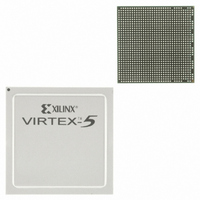XC5VLX50T-2FFG665I Xilinx Inc, XC5VLX50T-2FFG665I Datasheet - Page 93

XC5VLX50T-2FFG665I
Manufacturer Part Number
XC5VLX50T-2FFG665I
Description
IC FPGA VIRTEX-5 50K 665FCBGA
Manufacturer
Xilinx Inc
Series
Virtex™-5 LXTr
Datasheets
1.XC5VLX30-1FFG324C.pdf
(91 pages)
2.XC5VLX30-1FFG324C.pdf
(13 pages)
3.XC5VLX30-1FFG324C.pdf
(385 pages)
Specifications of XC5VLX50T-2FFG665I
Number Of Logic Elements/cells
46080
Number Of Labs/clbs
3600
Total Ram Bits
2211840
Number Of I /o
360
Voltage - Supply
0.95 V ~ 1.05 V
Mounting Type
Surface Mount
Operating Temperature
-40°C ~ 100°C
Package / Case
665-BBGA, FCBGA
For Use With
HW-V5-ML561-UNI-G - EVALUATION PLATFORM VIRTEX-5HW-V5-ML550-UNI-G - EVALUATION PLATFORM VIRTEX-5HW-V5-ML521-UNI-G - EVALUATION PLATFORM VIRTEX-5HW-V5GBE-DK-UNI-G - KIT DEV V5 LXT GIGABIT ETHERNET122-1508 - EVALUATION PLATFORM VIRTEX-5
Lead Free Status / RoHS Status
Lead free / RoHS Compliant
Number Of Gates
-
Available stocks
Company
Part Number
Manufacturer
Quantity
Price
Company:
Part Number:
XC5VLX50T-2FFG665I
Manufacturer:
Xilinx Inc
Quantity:
10 000
- XC5VLX30-1FFG324C PDF datasheet
- XC5VLX30-1FFG324C PDF datasheet #2
- XC5VLX30-1FFG324C PDF datasheet #3
- XC5VLX30T-1FFG665C_PRODUCT_CHANGE PDF datasheet #4
- Current page: 93 of 385
- Download datasheet (14Mb)
Virtex-5 FPGA User Guide
UG190 (v5.3) May 17, 2010
Clock Network Deskew
Frequency Synthesis Only
PLL_ADV Primitive
The PLL_ADV primitive provides access to all PLL_BASE features plus additional ports
for clock switching, connectivity to DCMs in the same CMT, and access to the Dynamic
Reconfiguration Port (DRP). The ports are listed in
can be found in the Virtex-5 FPGA Configuration Guide.
Table 3-2: PLL_ADV Ports
The Virtex-5 FPGA PLL is a mixed signal block designed to support clock network deskew,
frequency synthesis, and jitter reduction. These three modes of operation are discussed in
more detail within this section. The Voltage Controlled Oscillator (VCO) operating
frequency can be determined by using the following relationship:
where the M, D, and O counters are shown in
The six “O” counters can be independently programmed. For example, O0 can be
programmed to do a divide-by-two while O1 is programmed for a divide by three. The
only constraint is that the VCO operating frequency must be the same for all the output
counters since a single VCO drives all the counters.
In many cases, designers do not want to incur the delay on a clock network in their I/O
timing budget therefore they use a PLL or DLL to compensate for the clock network delay.
Virtex-5 FPGA PLLs support this feature. A clock output matching the reference clock
CLKIN frequency (usually CLKFBOUT) is connected to a BUFG and fed back to the
CLKFBIN feedback pin of the PLL. The remaining outputs can still be used to divide the
clock down for additionally synthesized frequencies. In this case, all output clocks have a
defined phase relationship to the input reference clock.
The PLLs can also be used for stand alone frequency synthesis. In this application, the PLL
can not be used to deskew a clock network, but rather generate an output clock frequency
for other blocks. In this mode, the PLL feedback path should be set to INTERNAL since it
keeps all the routing local and should minimize the jitter.
configured as a frequency synthesizer. In this example, an external 33 MHz reference clock
is available. The reference clock can be a crystal oscillator or the output of another PLL.
Setting the M counter to 16 makes the VCO oscillate at 533 MHz (33.333 MHz x 16). The six
Notes:
1. REL is used in PMCD mode only. In PLL mode, leave REL unconnected or tied Low.
Clock Input
Control and Data Input
Clock Output
Status and Data Output
Description
www.xilinx.com
F
F
OUT
CLKIN1, CLKIN2, CLKFBIN, DCLK
RST, CLKINSEL, DWE, DEN, DADDR, DI, REL
CLKOUT0 to CLKOUT5, CLKFBOUT,
CLKOUTDCM0 to CLKOUTDCM5, CLKFBDCM
LOCKED, DO, DRDY
VCO
=
=
F
F
CLKIN
CLKIN
×
×
-------- -
DO
Figure
M
---- -
M
D
Table
3-3.
Port
3-2. Detailed DRP information
Figure 3-5
General Usage Description
shows the PLL
(1)
Equation 3-1
Equation 3-2
93
Related parts for XC5VLX50T-2FFG665I
Image
Part Number
Description
Manufacturer
Datasheet
Request
R

Part Number:
Description:
IC FPGA VIRTEX-5 50K 1136FBGA
Manufacturer:
Xilinx Inc
Datasheet:

Part Number:
Description:
IC FPGA VIRTEX-5 50K 665FCBGA
Manufacturer:
Xilinx Inc
Datasheet:

Part Number:
Description:
IC FPGA VIRTEX-5 50K 1136FBGA
Manufacturer:
Xilinx Inc
Datasheet:

Part Number:
Description:
IC FPGA VIRTEX-5 50K 665FCBGA
Manufacturer:
Xilinx Inc
Datasheet:

Part Number:
Description:
IC FPGA VIRTEX-5 50K 1136FBGA
Manufacturer:
Xilinx Inc
Datasheet:

Part Number:
Description:
IC FPGA VIRTEX-5 50K 1136FBGA
Manufacturer:
Xilinx Inc
Datasheet:

Part Number:
Description:
IC FPGA VIRTEX-5 50K 665FCBGA
Manufacturer:
Xilinx Inc
Datasheet:

Part Number:
Description:
IC FPGA VIRTEX-5 50K 665FCBGA
Manufacturer:
Xilinx Inc
Datasheet:

Part Number:
Description:
IC FPGA VIRTEX-5 50K 665FCBGA
Manufacturer:
Xilinx Inc
Datasheet:

Part Number:
Description:
IC FPGA VIRTEX-5 50K 1136FBGA
Manufacturer:
Xilinx Inc
Datasheet:

Part Number:
Description:
IC FPGA VIRTEX-5 50K 1136FBGA
Manufacturer:
Xilinx Inc
Datasheet:

Part Number:
Description:
IC FPGA VIRTEX-5 50K 1136FBGA
Manufacturer:
Xilinx Inc
Datasheet:

Part Number:
Description:
IC FPGA VIRTEX-5 50K 1136FBGA
Manufacturer:
Xilinx Inc
Datasheet:

Part Number:
Description:
FPGA Virtex®-5 Family 46080 Cells 65nm (CMOS) Technology 1V 1136-Pin FCBGA
Manufacturer:
Xilinx Inc
Datasheet:

Part Number:
Description:
FPGA Virtex®-5 Family 46080 Cells 65nm (CMOS) Technology 1V 1136-Pin FCBGA
Manufacturer:
Xilinx Inc
Datasheet:











